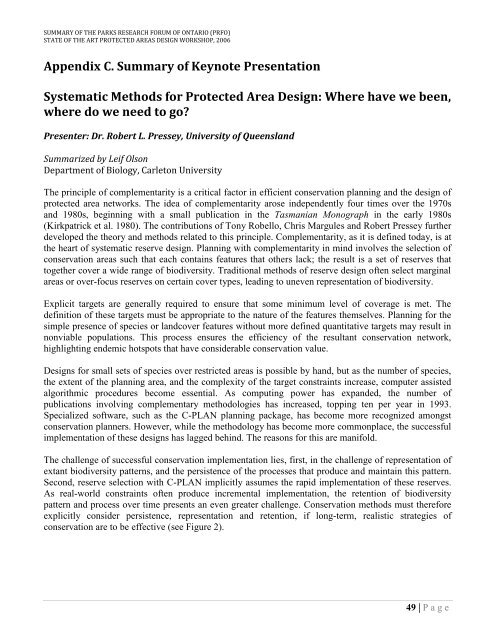Top-Down vs. Bottom Up: Working Towards Consensus ... - CASIOPA
Top-Down vs. Bottom Up: Working Towards Consensus ... - CASIOPA
Top-Down vs. Bottom Up: Working Towards Consensus ... - CASIOPA
- No tags were found...
Create successful ePaper yourself
Turn your PDF publications into a flip-book with our unique Google optimized e-Paper software.
SUMMARY OF THE PARKS RESEARCH FORUM OF ONTARIO (PRFO)STATE OF THE ART PROTECTED AREAS DESIGN WORKSHOP, 2006Appendix C. Summary of Keynote PresentationSystematic Methods for Protected Area Design: Where have we been,where do we need to go?Presenter: Dr. Robert L. Pressey, University of QueenslandSummarized by Leif OlsonDepartment of Biology, Carleton UniversityThe principle of complementarity is a critical factor in efficient conservation planning and the design ofprotected area networks. The idea of complementarity arose independently four times over the 1970sand 1980s, beginning with a small publication in the Tasmanian Monograph in the early 1980s(Kirkpatrick et al. 1980). The contributions of Tony Robello, Chris Margules and Robert Pressey furtherdeveloped the theory and methods related to this principle. Complementarity, as it is defined today, is atthe heart of systematic reserve design. Planning with complementarity in mind involves the selection ofconservation areas such that each contains features that others lack; the result is a set of reserves thattogether cover a wide range of biodiversity. Traditional methods of reserve design often select marginalareas or over-focus reserves on certain cover types, leading to uneven representation of biodiversity.Explicit targets are generally required to ensure that some minimum level of coverage is met. Thedefinition of these targets must be appropriate to the nature of the features themselves. Planning for thesimple presence of species or landcover features without more defined quantitative targets may result innonviable populations. This process ensures the efficiency of the resultant conservation network,highlighting endemic hotspots that have considerable conservation value.Designs for small sets of species over restricted areas is possible by hand, but as the number of species,the extent of the planning area, and the complexity of the target constraints increase, computer assistedalgorithmic procedures become essential. As computing power has expanded, the number ofpublications involving complementary methodologies has increased, topping ten per year in 1993.Specialized software, such as the C-PLAN planning package, has become more recognized amongstconservation planners. However, while the methodology has become more commonplace, the successfulimplementation of these designs has lagged behind. The reasons for this are manifold.The challenge of successful conservation implementation lies, first, in the challenge of representation ofextant biodiversity patterns, and the persistence of the processes that produce and maintain this pattern.Second, reserve selection with C-PLAN implicitly assumes the rapid implementation of these reserves.As real-world constraints often produce incremental implementation, the retention of biodiversitypattern and process over time presents an even greater challenge. Conservation methods must thereforeexplicitly consider persistence, representation and retention, if long-term, realistic strategies ofconservation are to be effective (see Figure 2).49 | P a g e


